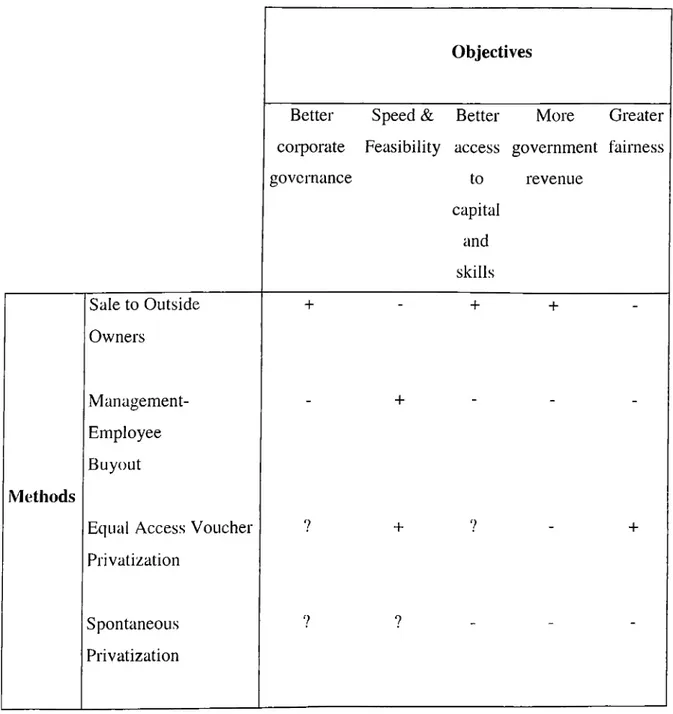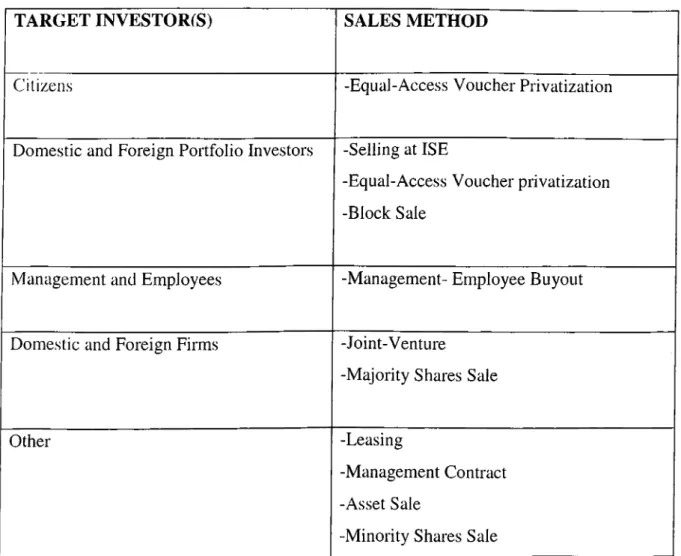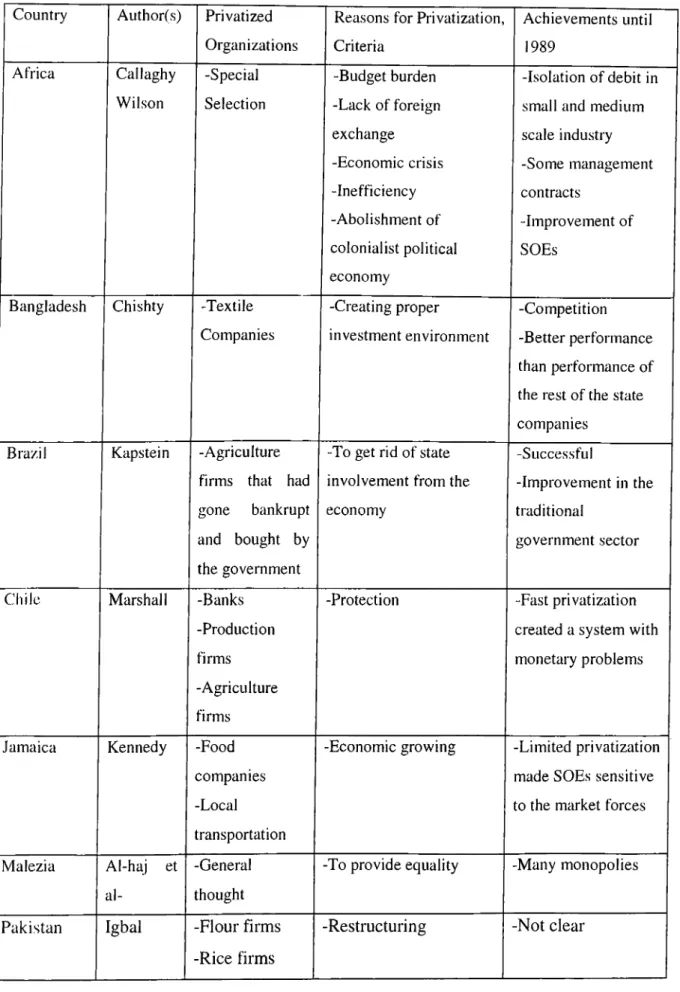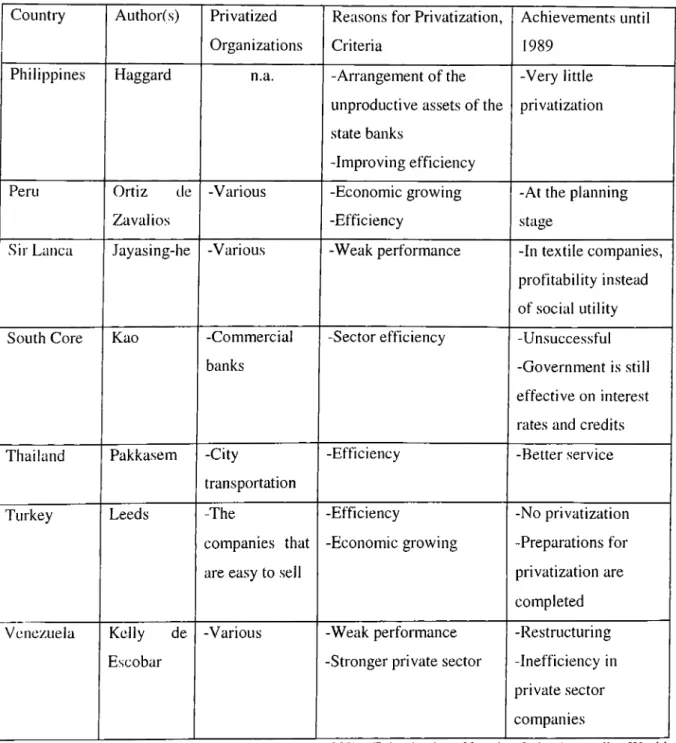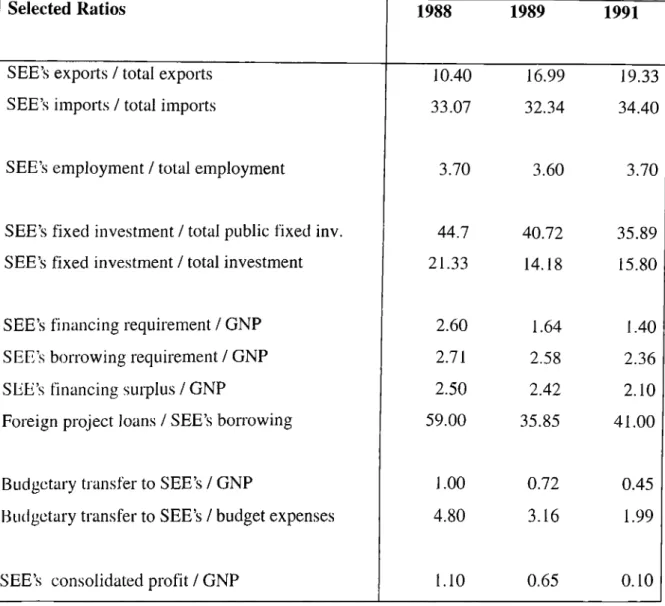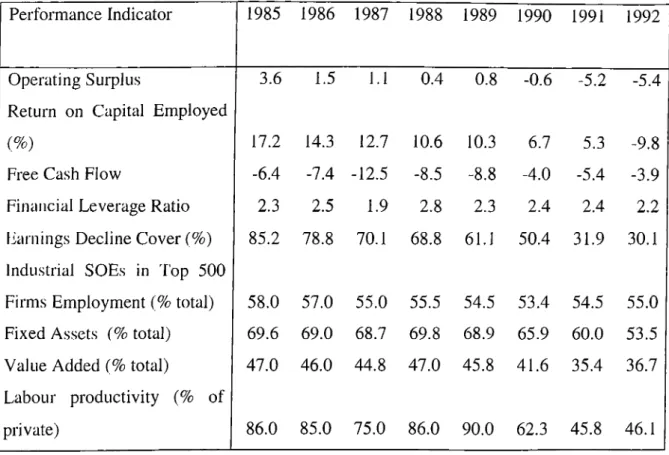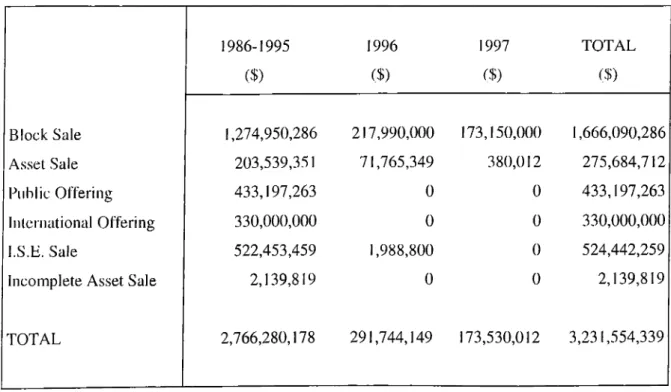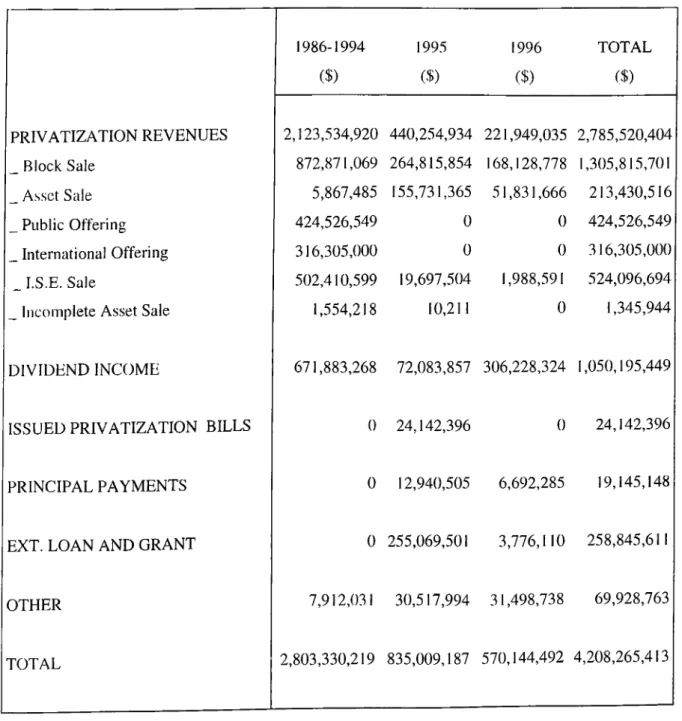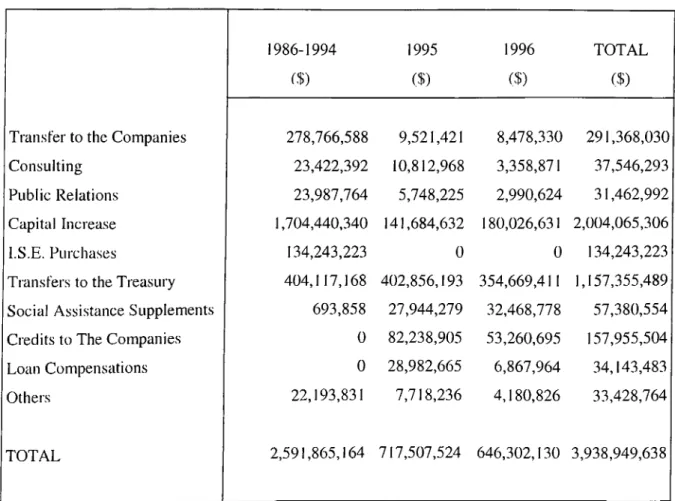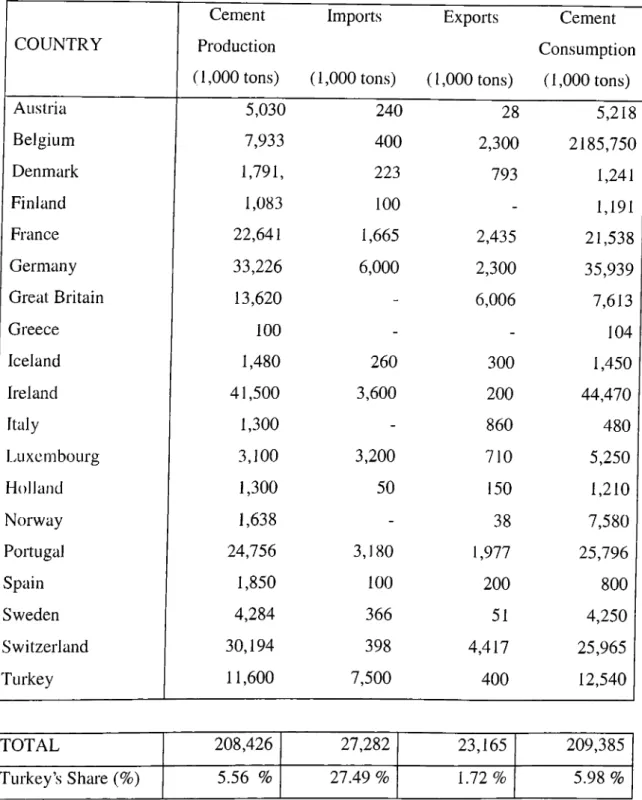I
1 ;;
PRIVATIZATION IN TURKEY
AND
PERFORMANCE ANALYSIS OF THE PRIVATIZED
COMPANIES
IN CEMENT INDUSTRY
A THESIS
SUBMITTED TO THE DEPARTMENT OF MANAGEMENT
AND
GRADUATE SCHOOL OF BUSINESS ADMINISTRATION
OF BILKENT UNIVERSITY
IN PARTIAL FULFILMENT OF THE REQUIREMENTS
FOR THE DEGREE OF
MASTER OF BUSINESS ADMINISTRATION
F. YE§tM AKCOLLU
I certify that have read the thesis and in my opinion it is fully adequate, in scope and in quality, as a thesis for the degree of Master of Business Administration.
Assist. Prof. Zeynep Önder
I certify that have read the thesis and in my opinion it is liilly adequate, in scope and in quality, as a thesis for the degi'ee of Master of Business Administration.
Assoc. Prof. Kürşat Aydoğan
I certify that have read the thesis and in my opinion it is fully adequate, in scope and in quality, as a thesis for the degree of Master of Business Administration.
Approved for the Graduate School of Business Administration
\|
ABSTRACT
PRIVATIZATION IN TURKEY AND PERFORMANCE ANALYSIS OF THE PRIVATIZED COMPANIES IN CEMENT INDUSTRY
F. YEŞİM AKCOLLU Master of Business Administration Supervisor: Assist. Prof. ZEYNEP ÖNDER
June 1997
Privatization is any transaction that reduces a government’s ownership in or control over a public enterprise or results in the liquidation and sale of assets of a public enterprise. Turkish experiment of privatization attracted researchers’ attention because of being an interesting case with an interactive triangle: relationship among the state, the society, and the international system. State Owned Enterprises were founded because of the desire of the Turkish Government to produce in the sectors where private sector was not producing. However, the f)erformance of state owned enterprises deteriorated over time. Privatizing the ones with poor performances seemed to be the best solution. Turkish Government had made a strong commitment to privatization after a new government established in 1983. However, no progress worth to mention about had been made until 1989. Privatization efforts have gained momentum afterwards. This study examines the performance of the privatization in cement industry by Wilcoxon rank tests and t-test by comparing the pre- and post-privatization performances according to several characteristics (such as profitability, operating efficiency, output, employment, leverage). According to the test results, privatized cement companies have no significant improvement after privatization in terms of performance measures other than sales efficiency.
ÖZET
TÜRKİYE’ DE ÖZELLEŞTİRME VE
ÇİMENTO SEKTÖRÜNDEKİ ÖZELLETİRMENİN PERFORMANS ANALİZİ
F. YEŞİM AKCOLLU İşletme Enstitüsü Yüksek Lisansı
Tez Danışmanı: Yard. Doç. Dr. ZEYNEP ÖNDER Haziran 1997
Özelleştirme, devletin bir kamu iktisadi teşekkülündeki payını ya da kontrolünü azaltan, veya kamu iktisadi teşekkülünün varlıklarının satımı veya tasviye edilmesi ile sonuçlanan her türlü işlemdir. Türkiye’nin özelleştirme çabaları, devlet, toplum ve de uluslararası sistemden oluşan bir üçgen olması nedeni ile araştırmacıların dikkatini çekmektedir. Kamu İktisadi Teşekkülleri, özel sektörün üretim yapmadığı alanlarda üretim yapmak için kurulmuşlardır. Fakat, zamanla performansları bozulmuştur. Kötü performans gösteren Kamu İktisadi Teşekküllerinin özelleştirilmesi en iyi çözüm olarak görülmüştür. Türk Devleti, 1983’te yeni hükümet kurulduktan sonra özelleştirme için kesin karar almıştır. Fakat, 1989 yılına kadar bahsedilmeye değer bir gelişme elde edilmemiştir. 90’h yılların başlarında özelleştirme çabaları hız kazanmıştır. Bu çalışma, çeşitli kriterlere (karlılık, işlemsel verimlilik, çıktı, istihdam, mali kaldıraç ) göre çimento şirketlerinin özelleştirme öncesi ve sonrası performanslarını karşılaştırmaktadır. Kullanılan yöntem t-testleri ve Wilcoxon sıralama testleridir. Çıkan test sonuçlarına göre özelleştirilen çimento şirketlerinin performanslarında satış verimliliği dışındaki kriterlerde dikkate değer bir gelişme olmamıştır.
ACKNOWLEDGEMENTS
First of all, I am thankful to Assist. Prof. Zeynep Önder for her supervision, guidance and suggestions throughout this work.
I would also like to thank Assoc. Prof. Kürşat Aydoğan and Assist. Prof. Ayşe Yüce for reading and commenting on my thesis.
I would like to thank Mr. Hans Otto-Moritz from the World Bank, Mr. Can Koral from ÇİTOSAN A.Ş., Mr. Müjdat Ekin from Privatization Administration, Mr. Turgay Akan from Privatization Administration, Mr. Ramazan Tezcan from Treasury for spending their time on explaining the subject matter to me and providing the necessary material for the thesis.
Finally, I would like to express my sincere thanks to my mother, my father and my sister for their love, patience and support throughout all my life.
TABLE OF CONTENTS ABSTRACT ÖZET ACKNOWLEDGEMENTS TABLE OF CONTENTS LIST OF TABLES LIST OF FIGURES I. INTRODUCTION
II. PRIVATIZATION PROCESS II. I Methods of Privatization 11.2 Problems in Privatization Process 11.3 Worldwide Privatization Efforts III. PRIVATIZATION PROCESS IN TURKEY
III. I Background of State Owned Enterprises (SOEs) III. I. I Composition and Importance
III. 1.2 Operations and Performance of SOEs
III. 1.3 The Main Reasons for the Poor Performance of the SOEs 111.2 Privatization Efforts
111.2.1 Objectives
111.3 Steps Taken for Privatization 111.3.1 Legal Preparations
111.3.2 Institutional Responsibilities 111.4 Obstacles in Privatization Process in Turkey
111.4.1 Organizational Obstacles
111.4.2 Obstacles in Privatization Operations 111.4.3 Obstacles with the Investors
111.4.4 Political and Legal Obstacles
11 iii iv vi vii I 4 4 8 8 12 12 12 14 16 17 19 20 20 21 22 23 24 25 26 I
111.5 The World Bank's Technical Assistance Projects for the State Owned Enterprises and 26 Privatization in Turkey
111.5.1 Technical Assistance Project For State Economic Enterprises 27 111.5.2 Privatization Implementation and Social Safety Net Project 30
IV. MEASURE OF PERFORMANCE OF PRIVATIZATION IV. 1 Performance Analysis in the World
IV.2 Performance Analysis in Turkey
37 37 38 V. RESEARCH METHODOLOGY AND FINDINGS
V. 1 Background and Structure of Cement Industry in Turkey V.2 Information About the Six Cement Companies in the Analysis V.3 Data
V.4 Hypothesis V.5 Methodology
V.5.1 T-test
V.5.2 Wilcoxon Signed Rank Test V.5.3 Wilcoxon Rank Test
V.6 Findings V.6.1 Profitability V.6.2 Operating Efficiency V.6.3 Output V.6.4 Employment V.6.5 Leverage
V. 7 Summary of the Findings VI. CONCLUSION
VI. I Overall Assessment of The Privatizaton Program in Turkey
VI. 2 Performance Analysis of the Privatized Companies in Cement Industry
REFERENCES APPENDIX 1 APPENDIX 2 APPENDIX 3 APPENDIX 4 40 40 44 45 45 48 48 49 49 50 50 54 54 59 59 63 66 66 68 70 74 77 78 80
LIST OF TABLES Table 1 Table 2 Table 3 Table 4 Table 5 Table 6 Table 7 Table 8 Table 9 Table 10 Table I Table 12 Table 13 Table 14 'I’able 15 3’able 16 Table 17 Table 18 Table 19 Table 20 Table 21 Table 22 Table 23
Trade-Off Between Privatization Methods
Sales Methods of Privatization According to the Target Investor Privatization Programs in Some of the Developing Countries
Selected Figures on the Performance of the SEEs in the Manufacturing Sector Key Performance Indicators of SOEs (1985 - 1992) (% of GNP)
Privatization Gross Revenues Cash Proceeds of Privatization
Privatization Expenditures (1986 -1996)
Privatization Implementations By Years (1985-1996) Cement Industry in Western Europe and Turkey in 1992
Summary of Hypothesis about Performance of Privatized Companies The Methodology Used to Measure the Performance of the Companies Return on Sales (ROS) = Net Income / Sales
Return on Assets (ROA) = Net Income / Total Assets Return on Equity (ROE) = Net Income / Equity
Sales Efficiency (SALEFF) = Sales / Number of Employees
Net Income Efficiency (NIEFF) = Net Income ($) / Number of Employees Real Sales (SAL) = Nominal Sales / Consumer Price Index
Total Employment (EMPL) = Total Number of Employees Debt to Assets (LEV) = Total Debt / Total Assets
Long-Term Debt to Equity (LEV2) = Long-Term Debt / Equity Results of T-test and Wilcoxon Rank Tests for the Six Companies Results of T-test for Each Company
U S T OF FIGURES
Figure 1; Breakdown of the Sale Methods in Privatization in Cement Industry
I. INTRODUCTION
" Any form of ownership is inevitably imperfect. Market failures can lead to divergence between profit and welfare objectives in private firms. Government failure leads to divergence between political / bureaucratic and welfare objectives in state-owned enterprises. Monitoring failure leads to divergence between the objectives of the enterprise managers and their principles, whether the principles are private owners or political superiors. The effects of ownership changes on welfare will depend upon the relative magnitudes of these imperfections. As a first approximation, privatization can be viewed as a means of reducing the impact of government failure, albeit at the risk of increasing market failures, and of changing monitoring arrangements. " (Vickers and Yarrow, 1991) Privatization is a process of change with political as well as socioeconomical dimensions; it is not a panacea for the ills of the economies in the developing world. The success of the newly conceived economic policies is anchored in the ability of the key actors to promote privatization by following effective macroeconomic policies and by building powerful coalitions of the public, politicians, bureaucrats, and special interest groups.
This study intends to analyze the privatization programs in Turkey including an analysis of performance of the privatized companies in the cement industry. It gives some information about why privatization is important in Turkey. Worldwide privatization efforts are also mentioned to make a comparison.
Second part gives the explanation of privatization and methods of privatization. Trade-off among the different methods of privatization and the methods according to the investor
the privatization programs in the world, the countries show different characteristics. Thus, we can not derive a generalization of the privatization applications and results worldwide. Third part examines privatization process in Turkey. First, it gives information about the background and composition ol State Economic Enterprises (SOEs) some of which were privatized and/or in the process of privatization. Then, the deteriorating performance of the SOEs and the main reasons of this deterioration are discussed. Then comes the privatization efforts ol Turkish Government including objectives. The steps and objectives of privatization process in Turkey since 1983 are discussed. Steps taken in this process, obstacles of privatization program in Turkey and World Bank Assistance projects to help privatization process in Turkey are also mentioned. At the end of this part, the present status and future privatizations are also evaluated.
Fourth part summarizes the measure of performance of privatization at the firm level. Several literature survey results are presented in order to reveal the efforts to measure the performance of the privatization both in Turkey and in the world.
Fifth part examines the performance of the privatized companies in Turkish cement industry. First, a brief explanation of the cement industry in Turkey is given. Cement industry constitutes an important aspect of privatization program in Turkey since it is the first industry where all state owned companies except very small two companies have been privatized. The six first privatized cement companies, namely Afyon, Ankara, Balıkesir, Söke, Trakya and Niğde are included in the sample. Several hypotheses regarding to the performance of these companies are tested. Their performance is characterized by their profitability, operating efficiency, output, leverage and employment level. Several proxies are used to measure these characteristics. For example, 'return on sales', 'return on assets', 'return on equity' ratios are used to measure profitability. For operating efficiency, ‘sales efficiency’ and ‘net income efficiency’ are used. Performance in terms of output is measured by ‘real sales’. ‘Total number of employees’ are used to measure employment level while ‘debt to assets’ and ‘long-term debt to equity’ ai'e used to measure leverage. The hypotheses are tested using t-test, Wilcoxon rank test and Wilcoxon signed rank test. For measuring the performance of each company, t-test is employed. For the overall performance of the six, both the t-test and Wilcoxon rank tests are employed. T-test and
Wilcoxon signed rank test are used to make of comparison between the two means. Wilcoxon rank test is employed to measure the difference between the two medians. The results of t-test and Wilcoxon rank tests are consistent although the sample size is not very large. According to the test results, there is no significant improvement after privatization in terms of profitability, output, leverage. In terms of operating efficiency, sales efficiency improved after privatization while net income efficiency has no significant improvement. Employment level in all companies decreases in post-privatization years as expected.
II. PRIVATIZATION PROCESS
Privatization is defined as any transaction that reduces a government’s ownership in or control over a public enterprise or results in the liquidation and sale of assets of a public enterprise. (World Bank, 1994) The most common objectives worldwide for privatization can be stated as follows:
• To minimize the state involvement in the economy,
• To increase both the operating and financial performance of the companies, thus increase the overall efficiency,
• i’o reduce the deficit and burden of debt,
• To foster market competition and discourage monopoly, • To raise country’s economic credibility and attract investment.
II. 1 Methods of Privatization
There are several methods of privatization. The following are the most commonly used methods (Nellis, 1996) :
• Direct Sale to Outside Investors: This method involves the sale of the privatized company to one or more buyers. Buyers can be both foreign and domestic. For example, in Germany, each company can be sold to at least two buyers.
• Management / Employee Buyout: Managers and employees are given the equal chances with others to be buyers of their companies. Sometimes, they have serious advantages over the outsiders.
• Voucher or Mass Privatization: In this method. The vouchers are used rather than money as the medium to purchase shares in companies. Vouchers are given or sold to domestic citizens at very low prices, thereby eliminating the shortage of domestic capital that is the core problem with the sale approach.
• Spontaneous Privatization: The privatization can take place indirectly, for example by the liquidation of assets or by selling some of the assets.
These methods of privatization have some advantages and disadvantages. Nellis (1996) expresses the trade-off among these privatization methods for large firms (Table 1). For example, direct sale is good in order to achieve better corporate performance and provide better access to capital and skills. On the other hand, it is slow and not very feasible.
Voucher privatization can overcome perceived unfairness, the shortage of domestic capital, and the difficulty of placing monetary values on state assets. It can proceed rapidly and can simultaneously stimulate the development of market institutions and create new stakeholders. However, the outcomes in terms of corporate governance and better access to capital and skills are blur.
Management-employee buyouts are fast and easy to implement, both from political and technical standpoints. Insider ownership can be more equitable and efficient than outside ownership.
The outcomes of spontaneous privatization either depend on other constraints or have negative results. It does not generate government revenue and does not provide a better access to capital and skills.
Table 1: Trade-Off Between Privatization Methods
Objectives
Better Speed & Better More Greater corporate Feasibility access government fairness
governance to revenue capital and skills Methods Sale to Outside Owners Management-Employee Buyout
Equal Access Voucher Privatization Spontaneous Privatization + + + +
Source; Nellis J. (1996), "Overall look to Privatization Worldwide", The World Bank Seminar
’+’: The method is proper for that kind of objective. : The method is not proper for that kind of objective.
’?’: The result highly depends on other constraints and it is hard to know the impact of the method without investigating other effects.
The selection of the privatization method depends on not only objective in the privatization process, but also the targeted investor in the privatized company. Sui9mez (1993) evaluates methods of privatization according to target investors. For example, if the aim is to allow as many as possible investor to take advantage of the privatization, then the most
appropriate solution is equal-access voucher privatization. However, if they are willing to give the priority to the employees and the management who have been working for the company for years, then the best method is management-employee buyout.
Table 2: Sales Methods of Privatization According to the Target Investor
TARGET INVESTOR(S) SALES METHOD
Citizens -Equal-Access Voucher Privatization
Domestic and Foreign Portfolio Investors -Selling at ISE
-Equal-Access Voucher privatization -Block Sale
Management and Employees -Management- Employee Buyout Domestic and Foreign Firms -Joint-Venture
-Majority Shares Sale
Other -Leasing
-Management Contract -Asset Sale
-Minority Shares Sale
Source: Sui^mez H., (1993), Privatization Applications in Turkey and in the World, National Productivity Center Pres.s
Nellis (1996) states the main common difficulties worldwide in the privatization process as follows;
• Corporate Governance: It is very difficult to change things that are malfunctioning into things functioning well such as obtaining reasonable price at a reasonable time frame. • Capital Markets: Registry, trading and minority rights are the critical issues in capital
markets to consider. In most cases, insider becomes dominant and it becomes very difficult to hold minority rights.
• Crime. Corruption and Regulation Difficulties: While the companies are privatized, in many cases, corruption and crime take place during the privatization process. Also, enacting the laws for the privatization process is very difficult. Benchmarking is very difficult since each country’s case differs from the others’ in many aspects.
• Business Advisory Services: During privatization process, the business advisory services are highly needed. Their experience in the subject matter is crucial.
II.3 Worldwide Privatization Efforts
A massive privatization effort has been taken worldwide. For example, between 1980 and 1991, 6,800 state owned companies were privatized in the world. Privatization was the number one priority in the countries facing transition economics such as Old Russia, Romania, Czech Republic, Slovakia, Macedonia, Hungary, Poland, Slovenia in early 90's. In these countries, 30,740 firms were privatized between 1990 and 1994 (Nellis, 1996). Currently, worldwide, 25 % of the total number of the companies are in the privatization portfolio of the governments. Those companies in the privatization portfolio constitute 35% of the total value of the firms worldwide (Nellis, 1996).
IL2 Problems in Privatization Process
Table 3 summarizes the results of several studies about privatization program in different countries (Vemon-Wortzel and Wortzel, 1989). According to that study, we can not conclude that there are similarities among the results of the privatization programs of the developing countries because of the scope of the privatization programs.
A study evaluating Turkish privatization programs found that there had been no real privatization until 1989 in Turkey, only the preparations for privatization program had been completed. According to his results, the main reason of the Turkish Government to initiate privatization program is the desire to increase efficiency and achieve economic growth. Turkish Government preferred to give the first priority in privatization program to the state owned enterprises that are easy to sell to get funding in short period of time.
Having examined the worldwide privatization process, next part explains the privatization process in Turkey. The third part of this study explains the background of state owned enterprises, privatization efforts up to now and future privatization plans, obstacles in the process. World Bank funded projects to help Turkish Government in privatization process.
Table 3: Privatization Programs in Some of the Developing Countries
Country Author(s) Privatized
Organizations
Reasons for Privatization, Criteria Achievements until 1989 Africa Callaghy Wilson -Special Selection -Budget burden -Lack of foreign exchange -Economic crisis -Inefficiency -Abolishment of colonialist political economy -Isolation of debit in small and medium scale industry -Some management contracts
-Improvement of SOEs
Bangladesh Chishty -Textile Companies -Creating proper investment environment -Competition -Better performance than performance of the rest of the state companies
Brazil Kapstein -Agriculture
firms that had gone bankrupt and bought by the government
-To get rid of state involvement from the economy
-Successful
-Improvement in the traditional
government sector
Chile Marshall -Banks
-Production firms -Agriculture firms
-Protection -Fast privatization
created a system with monetary problems
Jamaica Kennedy -Food
companies -Local transportation
-Economic growing -Limited privatization made SOEs sensitive to the market forces
Malezia Al-haj et
al--General thought
-To provide equality -Many monopolies
Pakistan Igbal -Flour firms
-Rice firms
Table 3 (Continued): Privatization Programs in Some of the Developing Countries
Country Author(s) Privatized
Organizations
Reasons for Privatization, Criteria
Achievements until 1989
Philippines Haggard n.a. -Arrangement of the
unproductive assets of the state banks
-Improving efficiency
-Very little privatization
Peru Ortiz cle
Zavalios
-Various -Economic growing
-Efficiency
-At the planning stage
Sir Lanca Jayasing-he -Various -Weak performance -In textile companies,
profitability instead of social utility
South Core Kao -Commercial
banks
-Sector efficiency -Unsuccessful -Government is still effective on interest rates and credits
Thailand Pakkasem -City
transportation
-Efficiency -Better service
Turkey Leeds -The
companies that are easy to sell
-Efficiency -Economic growing -No privatization -Preparations for privatization are completed Venezuela Kelly de Escobar
-Various -Weak performance
-Stronger private sector
-Restructuring -Inefficiency in private sector companies
Source: Vemon-Wortzel, H. and Wortzel L. H., (1989), “Privatization: Not the Only Answer” , World Development. Vol. 17, No:5, 633-641, Great Britain
I. PRIVATIZATION PROCESS IN TURKEY
The State Owned Enterprises (SOEs) were established since national independence war to function in the areas where the private companies were not producing. However, the performances of the SOEs deteriorated over time and they started to become a financial burden for the government . Because of the deteriorating performance of the SOEs, government stressed the need for improved performance of SOEs, including the shedding of SOEs through privatization and liquidation.
The privatization process was initiated in the early 1980s. Until the end of that era, no significant improvements are made. Since 1990, the privatization process gained acceleration. The Turkish experiment with privatization has been attracting the researchers’ · attention since it is an interesting case with an interactive triangle: the relationship among (he state, the society, and the international system at a particular point in time. In this part, first State Owned Enterprises are examined. Then privatization efforts of Turkish Government, future plans of privatization, obstacles to apply the program. World Bank projects to provide technical assistance and funding to the privatization program constitute the rest of this part.
IIl.l Back2round of State Owned Enterprises (SOEs)
III. 1.1 Composition and Importance
Slate Owned Enterprises can be classified in three broad categories (World Bank, 1993): • State Economic Enterprises (SEEs): They are the joint-stock companies wholly owned by the Treasury. An SEE reports to a ministry which is typically responsible for the policy-making and the co-ordination of the activities of the SEEs in an industry or sector.
Portfolios of the SEEs include a state bank which was to provide financing for the sector. Some of the SEEs are state monopolies.
• Wholly-Owned subsidiaries of SEEs and joint ventures with other private parties holding equity participation more than 50 %.
• Privately-owned or contracted enterprises with equity participation of the state through SEEs or subsidiaries.
The SOEs are mostly very large enterprises in the crucial sectors of the economy. Some of them are natural monopolies while others are virtually monopolies because of the very large size of investment required for the entry. Table 4 summarizes the important ratios of the SEEs in the manufacturing sector and their relative size in the Turkish economy. Although the investment made in the SEEs is high when compared to the sector’s total, the SEE’s profit share is very low compared to the sector’s total.
Table 4: Selected Figures on the Performance of the SEEs in the Manufacturing Sector
Selected Ratios 1988 1989 1991
SEE’s exports / total exports 10.40 16.99 19.33
SEE’s imports / total imports 33.07 32.34 34.40
SEE’s employment / total employment 3.70 3.60 3.70
SEE’s fixed investment / total public fixed inv. 44.7 40.72 35.89 SEE’s fixed investment / total investment 21.33 14.18 15.80
SEE’s financing requirement / GNP 2.60 1.64 1.40
SEE’s borrowing requirement / GNP 2.71 2.58 2.36
SEE’s financing surplus / GNP 2.50 2.42 2.10
Foreign project loans / SEE’s borrowing 59.00 35.85 41.00
Budgetary transfer to SEE’s / GNP 1.00 0.72 0.45
Budgetary transfer to SEE’s / budget expenses 4.80 3.16 1.99
SEE’s consolidated profit / GNP 1.10 0.65 0.10
Source: The World Bank, 1992, Privatization Implementation Assistance and Social Safety Net Project, Staff Appraisal Report, 4.
IIL1.2 Operations and Performance of SOEs
In the 1960s and 1970s, Turkey turned to SOEs as other developing countries such as Egypt, Tunisia, Tanzania did in order to provide that the private sector seemed incapable of producing. However, dissatisfaction with inefficiency and costs of SOEs has been very strong. Rather than making a contribution to the economics of Turkey, these enterprises turned out to be a substantial drain.
Table 5 shows the key performance indicators of the SOEs between 1985 - 1992. The financial performance of the SOEs worsened over time. The return on capital employed fell from 17.2 percent in 1985 to -9.8 in 1992. Particularly poor performers include TTK (Hard Coal Mines), ТЕК (electricity), TDCl (steel), and Siimerbank, all of which are consistently large loss-makers. Together, all loss-making SOEs accumulated losses of 1.9 % of GNP in 1990 which rose to 4.2 % of GNP in 1992. Economic efficiency were lagging behind the private sector. In 1992, the labour productivity in the SOEs were only the 46 % of that in the private, while the marginal efficiency of capital was only about one-third of the total.
Table 5: Key Performance Indicators of SOEs (1985 - 1992) (% of GNP)
Performance Indicator 1985 1986 1987 1988 1989 1990 1991 1992
Operating Surplus 3.6 1.5 1.1 0.4 0.8 -0.6 -5.2 -5.4
Return on Capital Employed
(%) 17.2 14.3 12.7 10.6 10.3 6.7 5.3 -9.8
Free Cash Flow -6.4 -7.4 -12.5 -8.5 -8.8 -4.0 -5.4 -3.9 Financial Leverage Ratio 2.3 2.5 1.9 2.8 2.3 2.4 2.4 2.2 Earnings Decline Cover (%) 85.2 78.8 70.1 68.8 61.1 50.4 31.9 30.1 Industrial SOEs in Top 500
Firms Employment (% total) 58.0 57.0 55.0 55.5 54.5 53.4 54.5 55.0 Fixed As.sets (% total) 69.6 69.0 68.7 69.8 68.9 65.9 60.0 53.5 Value Added (% total) 47.0 46.0 44.8 47.0 45.8 41.6 35.4 36.7 Labour productivity (% of
private) 86.0 85.0 75.0 86.0 90.0 62.3 45.8 46.1
Source: The World Bank, 1992, Privatization Implementation Assistance and Social Safety Net Project. Staff Appraisal Report, 4.
The main reasons for the poor performance of the SOEs can be stated as follows;
• Noncommercial Objectives; The Government has used SOEs to achieve a range of noncommercial objectives, including income redistribution, regional development, employment creation, and industrial and infrastructure development. Also SOEs are used by the government parties as the political power and a tool to increase their vote potential.
• Soft Budget Constraints; Unable to adjust to changing market demands, SOEs have survived only because of the soft-budget constraint. This has led to a pervasive lack of financial discipline. The availability of guarantees IVom the Treasury on foreign borrowings, loans and rediscounts from the Central Bank, and commercial bank loans have given SOEs preferential access to credit without facing the risk of bankruptcy. • Legal and Institutional Framework; In 1984, Decree Law 233 was issued to govern the
establishment and operation of virtually all SOEs in Turkey. In practice, deficiencies in that law effectively perpetuate outside control over SOEs through annual budgets and financing programs that require rectification by other public agencies. The new privatization law has been enacted only recently, on November 1994 as the law No; 4046.
> Pricing Policies; Although SOE prices are regulated by the authority of the SOE management by Decree Law 233, Council of Ministers can still set the prices and rate schedules. In practice, the legislation did not lead to full pricing autonomy. Also, the compensations of noncommercial duties imposed on the enterprises are generally paid with a lag of at least one year and without interest.
Personnel Regime; To circumvent the constitutional requirement to have SOEs managed by civil servants. Decree Law 233 introduced the possibility of hiring staff under one-year renewable contracts. This was done in order to attract better qualified people by offering higher salaries. However, the High Court of Justice ruled this
practice unconstitutional. Thus a category was introduced: civil servants with contracts. Salaries were not linked to the performance. Since 1989, the wage negotiations in SOEs have become highly politicized, leading to a more than doubling of the real wage workers in the two years to June 1992. At that date, the increases were moderated subsequently, with real wages increasing by 9 %. In addition, over employment policy of the government caused the personnel costs to increase a lot. While the number of personnel increased substantially, no extra value is added in terms of profitability and elficiency. New recruitments in the SOEs are seen as a way to decrease the unemployment rate by government.
• Market Regulation: Many large SOEs enjoyed the monopoly situation. The Government had to establish regulatory mechanisms to enhance efficiency and foster substantive private sector participation in those activities. Fundamental structural changes in the sector, including privatization, are needed to achieve an enduring improvement in performance.
Because of the reasons stated above, SOEs became a financial drain for the government and the need for privatization of the SOEs are deeply felt.
111.2 Privatization Efforts
After the national independence war that was ended in 1923, Turkey had no view of the respective roles of the private and public sectors. Government was bound until 1929 with the promises given with the capitulations. Much of the economy other than infrastructure were in public hands. Commerce was preferred over trade. The military and bureaucratic leaders of the time had a distrust of the private investors and the external world. On the other hand, they were favouring emulating the west to strengthen Turkey’s position. Therefore, state capitalism seemed to be the best solution for them. The state had a leading role in heavy industry (iron and coal) and light industry (textiles) while commerce and agriculture were left to the private sector. However, by the time as stated in previous section, SOEs became a financial burden for Turkish Government for the reasons stated in
The military regime, which held power from 1980 to 1983, achieved stabilization because it was able to put an end to economic failures, fight inflation, overcome political anarchy and civil disorder, and restore confidence in the financial credibility of Turkey. (Ancanlı and Rodrik, 1990).
At the beginning of 80s, the introduction of new economic strategies by the IMF and the World Bank to promote export and to develop a free market required a radical change in Turkish development strategy.
After being prime minister in 1983, Turgut Özal emphasized the excessive size and role of the state economic enterprises in the nation's economy. His solution was to encourage the private sector to achieve its full productive capacity.
Turgut Özal, was labelled as Turkey's economic czar and became famous as a believer in the private sector's ability to stimulate economic growth. Since Özal's government had to consolidate a broad coalition among groups with conflicting interests, they slowed down the pace of privatization and relaxed its fiscal policies.
Leeds (1987) studied the historical background of the SOEs and implementation of the privatization program that was initiated in 1983 by the Özal's government and evaluates the program between 1983 - 1987 as one of frustration, tension between competing national objectives, structural problems of both a political and an economic nature, and painstakingly slow process. He also criticizes the Minister Özal and his team by saying:" Prime Minister Özal and his team of like-minded technocrats encountered virtually all of the obstacles that would be contained in any privatization text book: political and^ bureaucratic resistance to change, a suboptimal macroeconomic policy environment and a relatively unattractive climate for private investment, controversy over the role of foreign advisors, weak and underdeveloped capital markets, inadequate staffing and a lack of indigenous technical knowledge of how to implement a privatization strategy, and political
r
uncertainty that undermined public confidence in the future of the program. As a result, seven years after the military government designated by Özal the nation's authority on economic policy, and four years after he was elected prime minister in his own right, no major state-owned enterprise had been privatized."
One of the World Bank reports (1993) described the situation:" Although Özal had committed his government to privatization, he was entering uncharted territory, and one of his most difficult problems was the paucity of staff with the expertise to implement the program and the resentment of foreign experts and foreign investors."
Shaker (1992) states that, contrary to expectations, export promotion did not lessen state intervention; it merely changed its direction. This new direction created significant changes- in state policies, which affected the interest groups (industrial, agricultural and private sector).
In the sixth five year plan (1990 - 1994), the Turkish government outlined broad economic policies, reiterating its emphasis on "privatization as a key instrument in reforming the economy."
The current privatization program, as launched by the former Motherland Party government in 1986 and approved by Demirel's government of 1991 - 1992, is centered on the sale of the government's shares in most of the SOEs and the restructuring of the state sector in order to prepare it for the sale to the public. It has been described by as " little more than a revenue-raising exercise which does not transform the structure and ownership of the Turkish industry."
III.2.1 Objectives
Turkish Government has had almost the same objectives with the other developing countries which have initiated privatization programs recently. The main objectives can be stated as follows:
• To minimize state involvement in the industrial and commercial activities of the economy,
• To accelerate further establishment of market mechanisms within the context of liberal
economic policies,
suitable legal and structural environment for free enterprise to operate, • To enhance the competition in the economy,
• To decrease iht financial burden of the State Economic Enterprises on the national budget,
• To broaden and deepen the existing capital market by promoting wider share ownership,
• To provide efficient allocation o f resources,
• To transfer privatization revenues to the major infrastructure projects.
III.3 Steps Taken for Privatization
This section explains the legal and the institutional preparations done in order to achieve these objectives.
III.3.1 Legal Preparations
After the privatization program was initiated in 1983, the first two related regulations. Law No: 2983 and Law No:3291 were enacted in 1984 and in 1986, respectively. Within the perspective of the provisions of Law No: 3291, the Council of Ministers was authorized to give decision on the transfer of SOEs to the Public Participation Administration (PPA) and the High Planning Council was authorized to decide on the transfer of partially state owned companies and subsidiaries to the PPA for privatization. In 1992, with the Statutory Decree No: 473, Public Participation High Council (PPHC) was authorized to approve privatization transactions.
Upon formation of a political and social consensus on the needs for privatization, the new privatization law has been enacted on November 1994 as the Law No: 4046. Within the context of the new law. Public Participation High Council has been replaced with Privatization High Council (PHC) which is chaired by Prime Minister and the Public Participation Administration has been replaced with Privatization Administration (PA).
III. 3.2 Institutional Responsibilities
IV. 3.2.1 Privatization High Council (PHC)
PHC is the ultimate decision making body for privatization and is composed of Prime Minister, Minister of Finance, Minister of Industry and Commerce and two ministers of State. Its main responsibilities are determined by Law No:4046 as follows:
• Decide on the transfers of State Owned Enteiprises (SOEs), equity participants and assets either to the Privatization Administration (PA) or to Undersecretariat of Treasury and Foreign Trade (UTFT) for rehabilitation and restructuring prior to privatization, • Decide to transfer enterprises to other public institutions and local administrations
when required for national security and public interest,
• Decide to take SOEs out of privatization portfolio if need arises, • Decide on the method of each privatization for each SOE,
• Decide on downsizing, ceasing or operations, close down or liquidation of companies under privatization,
• Approve privatization transactions, evaluate the privatization applications and programs, and take the necessary measures against problems,
• Approve budgets of the Privatization Fund (PF) and PA,
• Decide to issue domestic and foreign debt in various forms to be used for Privatization Fund,
• Decide on transfers from Privatization Fund to UTFT for necessary expenditures for restructuring and rehabilitation of SOEs to be privatized,
• Approve other issues related to the Privatization Fund,
• Decide to buy and sell shares and all commercial papers of SOEs in Privatization portfolio.
IV.3.2.2 Privatization Administration (PA)
PA is the executive body for privatization . Its main responsibilities and duties are:
. Advise PHC in matters related to the transfer of SOEs into or out of privatization portfolio, and for the need of restructuring and rehabilitation of SOEs,
• Direct SOEs to prepare for privatization by,
- Deciding whether SOEs should be converted into joint-stock companies and valuing in-kind capital to be contributed by the SOE being converted, - Determining the capital of SOEs till PA’s shareholding falls below 50%, - Governing the financial, administrative, legal and technical structures of
SOEs,
- Deciding on demands from SOEs for obtaining assets, hiring or laying-off personnel,
- Proposing Prime Minister nominees for Board of Directors and top management appointments,
- Carrying out valuations of the SOEs or part of their assets, - Giving loans to SOEs,
• Manage Privatization Fund.
III.4 Obstacles in Privatization Process in Turkey
Privatization is not a very easy operation especially in the developing countries like our country. During privatization program, there occur lots of obstacles. In SOEs to be privatized, there were lots of things to be considered along with the financial and economic aspects of the privatization program.
Despite the well-publicized goals of privatization, only 0.5% of fixed assets of the SOEs could be sold until 1990 (Privatization Administration Bulletin, 1997). According to a World Bank report, only a few sales could be defined as privatization, since the public sector is still in control of these companies. As of January, 1997, there are still 55 companies in the privatization portfolio, 22 of which are 100% government owned.
”In evaluating the Turkish experience of the 1980s, one has to confront the apparent paradox of a tremendously successful external adjustment pitted against several internal imbalances. While the government launched a round of further trade and foreign exchange liberalization in the summer of 1989 to fight inflation, the government alienated all but the 'rentier groups' and the policies have had scarcely any effect on price stability.” (Rodrik , 1990)
Heper and Evin (1993) states that the government has not displayed a consistent sense of the purpose and direction. "At times, it is said that the funds raised by the state would be recycled into new public investments. This required an overestimation of the value of fixed capital to be transferred. At other times, the impression was given that the government simply wanted to get rid of the SEEs altogether, for political and financial reasons. This, in turn, necessitated an underestimation of the sale value. More recently, macroeconomic considerations came to the fore. The inefficient operation of the SEEs is perceived to be one of the major stumbling blocks in the efforts to stem inflation."
Oni§ and Riedel (1993) argue that Turkey’s macroeconomic problems were homegrown, and successive governments pushed the economy beyond stability because of the political imperatives that were closely related to the needs of the broad national coalition. They argue that, until the military takeover of September 1980, "too often governments in Turkey tried to build a broad coalition by promising the various political constituencies more than they could deliver, causing economic instability and, periodically, a crisis." Those obstacles can be examined according to the subtitles: organization itself, investors, pi ivalization operations, political and legal problems.
IIL4.1 Organizational Obstacles:
The studies of several researchers about the subject matter can be summarized under the subheadings: overemployment, old technology, management, production and marketing. • Overemployment: In SOEs , the recruiting was not done according to profitability or
efficiency, but rather by considering the social and political reasons. After privatization, employees should be taken in a very systematic social safety net for training and creation of new employment alternatives. That caused an overemployment in those companies which resulted in increasing salary costs when compared to the private sector personnel costs. On the other hand, seniority compensations of the SOE employees that should be paid after privatization were more than the private sector seniority compensation, causing extra personnel cost.
• Old Technology: In most of the SOEs, the technology was very old and thus, causing the costs to be very high and the profits very low. These companies needed high investments to be more profitable. The need for high investment makes the sale of the SOE difficult for the state.
• Financing Problem: Although the transfers were made from the several state organizations to the SOEs, by the time, because of the mismanagement, they ran out of their financial resources. Thus, they tried to finance from external sources with high interest rates. Having high debt/equity ratios makes the privatization for those companies more difficult.
• Management: Most of the time, the employees in the management of the SOEs are not knowledgeable enough about finance, marketing, sales methods, high technology requirements. Besides, top management personnel changes frequently because of the political reasons thus causing inconsistency in managerial decisions, lack of strategic planning, demotivation among employees. Some of the bureaucrats may resist privatization of the companies that are under their supervision because of the fear of the risk of losing their power.
• Production and Marketing: State organizations are production-oriented meaning marketing divisions are responsible of selling what production divisions produce. They do not have any idea of being consumer-oriented. State organizations are very powerless in terms of marketing and sales power when compared to the private organizations. Selling an organization that is not powerful in either marketing or sales is a very difficult task.
III.4.2 Obstacles in Privatization Operations:
• Timing: The timing of the privatization of an SOE is very important because the market forces at that time affect the demand for the advertised SOEs. Also, in going to public cases, the stock market conditions play an important role.
• Sales Methods and Comparative Advantages vs. Disadvantages of Those Methods: "There is no perfect method for privatization. All have advantages and disadvantages." states John Nellis in his seminar at the World Bank in October, 1996. Table 1 shows the summary of his presentation in section II. 1. Privatization in Turkey is usually achieved by block sale, thus carrying the risk of monopolization / oligopolization. • Priorities in Privatization: Since there are constraints such as the time to apply the
privatization plan, financial constraints, social safety net of the employees that are working for SOEs, the priorities should be stated beforehand according to the objectives of the government.
• Revaluation of the Assets: In order to provide the condition that the assets of the state companies are sold at their real value, at the end of each year , they are revalued by the Law 2791 since January 21, 1983. The main obstacle here is that usually the revaluation rate is below inflation rate causing the company’s assets to be seen less valuable than their real value. In 1995, the revaluation rate was 40% while inflation rate was 93% which was much more above revaluation rate.
III.4.3 Obstacles with the Investors:
, Insufficiency of Stock Market Intermediaries: In the countries like Turkey where the stock market is quite new, the investors have limited services. The citizens living in rural areas of the country do not have a direct access to the stock market. Besides, the information about the financial data of the firms may not be true.
Shaker (1991) defines the more general problem in privatization in Turkey as weak capital markets and a low level of profitability among SOEs. She states: "In other words, the enabling environment that can effectuate the transition to a free market economy is not available. This seems puzzling, considering the government’s enthusiasm to privatize. One major factor that needs to be taken into account is that privatization is not merely cosmetic. The process entails societal change as well as political and economic changes, and the difficulty is compounded because those who
• Saving Habits of the Investors: Investors may be unwilling to invest their money in stock market by rather preferring to invest on gold, foreign exchange, real estate, etc. To attract the demand for the privatized companies, special efforts such as advertising, publicity are necessary.
111.4.4 Political and Legal Obstacles
in Turkish case, we see a very common feature in the privatization implementations: .Political and bureaucratic resistance to change. One component of it is the resistance to change that is common for almost every company’s employees. The other component of ' the obstacle is the fear of losing some part of political power after the companies are privatized.
While the protection creates rents, removing it penalizes not only workers but also certain elites who have been receiving rents as a windfall and government officials who see their / power disappear with liberalization of the economy. Consequently, observers argue that privatization was not perceived as a positive-sum game in Turkey. (Heper, 1990)
Lack of proper laws for privatization procedures from the beginning and the frequent , changes in the laws tiuit were effective in the privatization program implementations made the implementation slow and inconsistent.
1II.5 The World Bank’.s Technical Assistance Projects for the State Owned Enterprises and Privatization in Turkey
The World Bank’s policy on privatization evolved from its experience in assisting member countries through structural adjustment and investment operation, economic and sector work on the reform of the public enterprise sector, and work related to private sector development. The World Bank’s role in the coordinated assistance to the countries with International Fiduciary Corporation (IFC) and Multilateral Investment Guarantee Agency (MIGA) is to provide on how to bring about an enabling environment, laws and regulations related to privatization, and the classification of public enterprises in line with the client
borrower’s objectives. The Bank also gives advise on the design of specific privatization programs, including the selection of the enterprises for privatization, development of necessary institutions, and the design of regulations governing transactions (World Bank,
1994).
The World Bank gave loans to Turkish Government in order to assist the privatization program. The major projects are as follows:
• Technical Assistance Project For State Economic Enterprises (Loan 2400-TU), • Privatization Implementation and Social Safety Net Project.
IIL5.1 Technical Assistance Project For State Economic Enterprises (Loan 2400-TU)
The project (Loan 2400-TU) was approved by the Executive Directors in March 1984, and was signed three weeks later.
II1.5.1.1 Objectives
The SOE reform decree provided a framework for improving the financial, managerial and operational efficiency of the SOEs. However, Government of Turkey recognized that its operationalization depended on how readily the SOEs would avail of their new managerial autonomy and take steps to change the deep-rooted attitudes of their managers and boards. Against this background, the Bank and Turkish Government decided to improve the operational efficiency of the selected SOEs. That application would constitute an important demonstration effect for the other SOEs. The criteria for the selection of participating SOEs were:
• Receptivity of the SOE management to the objectives of technical assistance, • Ongoing direct or indirect relation between the World Bank and the SOE, • Possibly the role of the SOE in expending exports.
The project was to complement ongoing Bank efforts to assist some SOEs in their rationalization / modernization programs.
III.5.1.2 Project Components
The loan was given to finance the technical assistance in support of the identified programs of three SOEs selected by government as noted below:
• Turkish Coal Corporation ($ 2.95 million) - for improved management information system, streamlining of procurement of equipment, spare, training and manpower planning, and improvement management of lignite mines;
• Siimerbank (A conglomerate with operations in banking, manufacturing and retailing - $ 2.45 million) - for reorganization and rationalization of sales and retail organization, improvement of management and data processing systems, feasibility study for the rationalization and modernization of Siimerbank's wool textile operations;
• Turkish Railways (TCDD / ADVAS) (One of the three main workshops / manuhicturing establishments of Turkish Railways - $ 0.98 million) - for improved cost estimation through appropriate breakdown of operations, improvement of operations planning and scheduling, including the management information systems to product qualily, improving manual inventory management and control through the introduction of automated systems, and improved work organization and layout in production and repair focilities.
Project also provided funds for the technical assistance for other potential beneficiaries, services for consultants and equipment to better define user need, establish standards of data accuracy.
The Bank Loan was to be channelled to the SOEs through State Investment Bank (DYB), which had previously supported by the Bank.
1II.5.1.3 Project Design and Organization
The project was designed to demonstrate that by fully of the power and flexibility within the prevailing Turkish Government rules and procedures, and concurrently seeking
assistance to enhance their operational efficiency, SOEs could significantly improve their overall performance. Whereas the SOEs, particularly those with which the Bank had an ongoing relationship, recognized the need for operational improvements, the precise nature of the additional changes to be promoted under the project and their scope and timing may not have been the subject of a fully participatory discussion within Turkey.
111.5.1.4 Project Implementation
The approval was a year later than the planned date, because of the delay in enacting the Decree law. The original date of effectiveness was July 16, 1984, however it was extended three times before the Loan become effective in December 1984.
The implementation of the project encountered delays and serious problems from the outset, and there was little or no activity pertaining to the three SOEs for several months. There were delays in finalizing the consultants’ short lists and letters of invitation, and terms of reference for studies.
The Coordination Committee which was suppo.sed to monitor the progress of the project and resolve the problems which surfaced proved to be ineffective because it was never built up to full strength, replacement were not promptly found for departing members, and the fii st chairman was preoccupied with other pressing matters.
111.5.1.5 Project Costs and Financing
The Bank provided a loan of $ 7.6 million over a three year period in order to finance technical assistance in support of the identified three SOEs selected by Turkish Government.
111.5.1.6 Project Results and Assessment
During the implementation of the project, some components of the project were revised so that there was little or no action pertaining to the original project components such as the
both high level Government personnel and Bank staff directed towards operationalizing the philosophy and program of the new Government, particularly with regard to industrial restructuring and privatization.
111.5.2 Privatization Implementation and Social Safety Net Project
ni.5.2.1 Objectives
Main objective of the project is to promote efficiency and productivity and the further development of Turkey’s dynamic private .sector by providing assistance for an accelerated privatization process (World Bank, 1994). The project would also help lay the basis for more comprehensive privatization and sustained fiscal contraction in the future. It would build up institutional capacity through technical assistance and the experience gained through the implementation of the current program, thereby enabling the Government’s administrative machinery to manage the larger and more complex workload entailed by a broader divestiture program. Another important objective is to alleviate the adverse impact of SOE downsizing and divestiture on displaced workers and their families.
111.5.2.2 Project Description The project would include:
• Technical and financial support for the preparation and implementation of privatization transactions; a public information campaign to promote and broaden public support for the Government’s privatization agenda; the strengthening of PA; and the strengthening of the capacity of the Undersecretariat of Treasury and Foreign Trade to manage the debt liabilities of SOEs to be privatized,
• Social safety net measures, including labour adjustment programs to determine the extent of labour displacement in individual SOEs, assess the demand for labour services, and provide counselling, retraining, and small business assistance through local institutions; the strengthening of agencies responsible for the labour adjustment programs; and studies to analyze the options for the reform of the social insurance / pension systems, • The preparation of a regional development plan to diversify the economic base of the Zonguldak region, where a high concentration of layoffs in steel and mining operations
is likely,
• Studies to develop a regulatory framework for the privatization of the telecommunications sector and establish a coordinated strategy for the private provision of inlrastructure services.
III.5.2.3 Project Costs and Financing
Total project costs were planned to be $ 129 million. Of the total Bank would finance $ 100 million and the Government would finance $ 29 million.
III.5.2.4. Project Implementation
PA would be responsible for the implementation of the privatization component, including the public information campaign. Treasury would be responsible for managing the SOEs’ debt liabilities. The implementing agencies such as Treasury would need technical assistance, training, new responsibilities. Contract staff would be u.sed according to the workload by the privatization effort.
Treasury would monitor the labour adjustment part with technical assistance. It would also act as the channel for directing loan funds to lead agencies which would be responsible for delivering the labour adjustment at the local level. The transfer and the use of the funds would be in accordance with criteria agreed with the Bank. Treasury would be responsible for the studies to be carried out under the project. The State Planning Organization would be responsible for the preparation of the Zonguldak regional development plan.
1II.5.2.5 Project Results and Assessment
The project was mainly to assist three SOEs to improve operational and financial efficiency, however operational component never worked. Three month after the loan approval, the new Government issued a more sweeping decree on privatization and restructuring of SOEs than the one existing during loan approval. The utilization of funds are agreed to be transferred to the privatization studies precedent to privatization. Although
Privatization implementations started in 1984 with the transfer of incomplete plants of the SOEs to the private sector to be completed or to construct a new plant. In this juncture, 6 plants were sold to different investors and 9 plants were transferred to municipalities or state enterprises on book value.
Since 1986, privatization implementations have gained momentum and 114 companies were privatized either via sale of shares or asset sale. Among those, no state shares were left in 95 companies (Privatization Administration Bulletin, 1997). Appendix 1 has the list of the completely privatized companies as of January 1, 1997.
Table 6: Privatization Gross Revenues
III.6 Where We Are Now in Privatization Process
1986-1995 ($) 1996 ($) 1997 f$) TOTAL ($) Block Sale 1,274,950,286 217,990,000 173,150,000 1,666,090,286 Asset Sale 203,539,351 71,765,349 380,012 275,684,712 Public Offering 433,197,263 0 0 433,197,263
Inlei national Offering 330,000,000 0 0 330,000,000
l.S.B. Sale 522,453,459 1,988,800 0 524,442,259
Incomplete Asset Sale 2,139,819 0 0 2,139,819
TOTAL 2,766,280,178 291,744,149 173,530,012 3,231,554,339
Source: Privatization Administration Bulletin, May 14, 1997
Since 1985, total sales of privatization implementations has been about $ 3.2 billion as seen In Table 6. Some of these asset and share sales were made on installment compensation and foreign exchange basis. As of May 14, 1997, $ 2.8 billion net privatization revenue have been realized. The discrepancy between sales value and net
revenues derives from interest on compensation by instalments and exchange rate variations in case of foreign exchange compensations.
Total income from organizations on the privatization program during the 1985-1997 period, including $ 1 billion dividend income reached to $ 4.2 billion as seen in Table 7. Table 7: Cash Proceeds of Privatization
1986-1994 1995 1996 TOTAL ($) ($) ($) 1$) PRIVATIZATION REVENUES 2,123,534,920 440,254,934 221,949,035 2,785,520,404 _ Block Sale 872,871,069 264,815,854 168,128,778 1,305,815,701 _ Asset Sale 5,867,485 155,731,365 51,831,666 213,430,516 _ Public Offering 424,526,549 0 0 424,526,549 _ International Offering 316,305,000 0 0 316,305,000 _ I.S.E. Sale 502,410,599 19,697,504 1,988,591 524,096,694
_ Incomplete Asset Sale 1,554,218 10,211 0 1,345,944
DIVIDEND INCOME 671,883,268 72,083,857 306,228,324 1,050,195,449
ISSUED PRIVATIZATION BILLS 0 24,142,396 0 24,142,396
PRINCIPAL PAYMENTS 0 12,940,505 6,692,285 19,145,148
EXT. LOAN AND GRANT 0 255,069,501 3,776,110 258,845,611
OTHER 7,912,031 30,517,994 31,498,738 69,928,763
